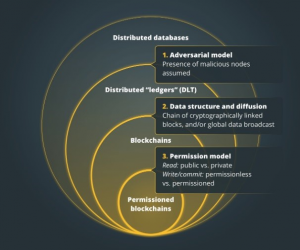Difference Between Blockchain and Distributed Ledger (DLT)
]The concepts of “blockchain” and “distributed ledger technology (DLT)” are often used interchangeably, although, in fact, they are not. This material will help you understand the distinctive features and no longer get confused in the definitions.
Difference from a Technical Point of View
In order for the article not to be amorphous, we’re going to make a technical comparison first and define the concepts.
DLT is an information storage technology whose important features are the absence of a central authority, the sharing and synchronization of information according to a consensus algorithm, and, most importantly, the distribution of this database in different geographical locations.
The frequently occurring words registry, book, and journal are abstract implementations of the “DLT-table” concept. A DLT table is a technical term that defines a two-dimensional array data structure that was created long before Bitcoin.
The differences are best seen in examples. Ripple is one of the current examples of DLT because recently, Bank of America filed a patent application for a settlement system based on Ripple distributed ledger technology. Ripple’s developments are great for banks and really find practical application, so their technology deserves to be a representative of DLT.
The classic examples of blockchain are Bitcoin and Ethereum, so they will be representatives from the blockchain family.

Substitution of Concepts

The illustration shows that distributed ledger is the underlying technology of distributed databases, while the blockchain is just a type of DLT. The main difference lies in one important aspect – decentralization.
On a public blockchain, anyone can become a miner or set up a node to directly participate in data validation, while DLT tables can be private. Blockchain is necessarily open to everyone to use and manage, while DLT structures are necessarily distributed but not necessarily decentralized.
FYI
The best thing about the difference between decentralization and distribution is described in the book by Siraj Raval, “Decentralized Applications. Harnessing Bitcoin’s Blockchain Technology”.
The notion of a “private blockchain” is even more misleading. Such a phrase should not exist at all, and marketers are to blame for its creation who in 2017-2018 began to massively add the hype word “blockchain” to promote products based on private distributed registries. As a result, the concept of blockchain has grown into a “public blockchain” in order not to confuse God’s gift with scrambled eggs.
“In the corporate space, people use the concept of “private blockchains”, although it is fundamentally wrong from a technical point of view. Such products are not blockchains at all, rather they can be called an advanced database management system,” says Phil Chen, head of HTC Exodus.
Chen still gives credit to private blockchains in terms of technology development: “The performance gain compared to the classic blockchain is huge. I would even give these innovations a score of 9 to 10, while the public blockchains of Bitcoin and Ethereum can be given a score of 0 to 1.
Unfortunately, the technologies on which Bitcoin and Ethereum are based turned out to be inconvenient for mass adoption, while private distributed registries in many aspects are better suited for practical implementation. The proof is the list of the richest corporations investing in blockchain. Out of ten companies, nine use products based on DLT tables.
In a distributed DLT ledger, the number of who can become, use, and access a node is limited. Governance decisions remain with a single company or group of companies, as in Facebook’s Libra blockchain. Compared to Bitcoin and Ethereum, Ripple DLT serves the interests of a concentrated group of commercial corporations, in this case, banks. And banks do not need a public blockchain at all, if only for reasons of confidentiality of their clients’ data.
As for the timestamp of adding data, it can be both in the public blockchain and in the usual DLT table, so transaction timestamps cannot be attributed to differences. As an example, let’s take Corda R3, a distributed DLT that has a consensus algorithm and timestamps but no blockchain.
Conclusion
So, the main difference between the general concept of DLT and blockchain is decentralization, which is optional in DLT but mandatory in a public blockchain.
For premium readers








